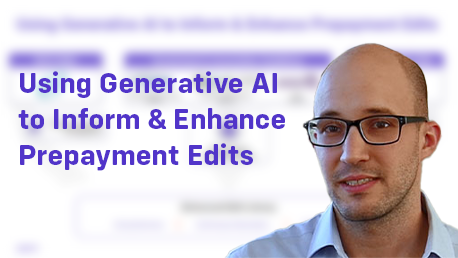As payment integrity efforts increase, innovation must keep up
The payment integrity industry is heating up. With a 7% CAGR in recent years, it is now worth $9 billion. This growth is likely to continue as US health care spending skyrockets, and between 3% and 10% of health care claims, worth $300 billion, are deemed fraudulent.
Payors have a lot on their plate ensuring payment accuracy. They need to stay up-to-date on evolving care delivery models and policies – as well as quickly and accurately ingest and analyze records – as they strive to comply with prompt pay laws and maintain positive provider relationships amid this growing effort.
However, unstructured data, cumbersome requests, data access issues, and manual document management, review and analysis are limiting effective payment integrity programs. Additionally, there is increased pressure on health payors due to prompt pay laws, provider abrasion, inaccuracies and missed savings opportunities.
While some payors have processes or solutions in place already to stop or flag suspicious claims throughout the claims process, they often produce high rates of false positives or require frequent updates to business rules, “which ultimately leads to overspending and inefficiencies,” says Mark Starinsky, healthcare product lead for Shift Technology.
Fortunately, Generative AI (GenAI) resolves these issues for both payors and providers with faster, more accurate and more insightful data reviews, allowing for less pressure, greater ROI and more time and resources to devote to patient care.
Major PI pain points
- Extensive resources involved in prepayment review of provider claims
- Provider abrasion
- New opportunities for claims errors due to changing care delivery models, policy or billing and reimbursement guidelines
- Document management, review and analysis, including manually extracting data points and matching them to claims
- The need to ingest and analyze paper records and notes from providers
- Identification of copy/pasted language used across multiple claims
- Analysis of medical images to flag misused or AI-generated submissions
- Knowledge gaps within teams
Is GenAI right for your Payment Integrity goals?
Payment Integrity capabilities depend on rapid review and analysis of many data sources, and of both structured and unstructured information. Even small improvements in the accuracy and efficiency of claims adjudication can result in significant financial gains.
GenAI is emerging as a solution to help Payment Integrity teams work more accurately and efficiently than previously possible. GenAI does more than analyze data — it produces new data in various and more usable forms. It can flag errors, copy/paste language or unusual data so that teams of coding experts and clinicians can quickly focus on reviewing more complex claims and documents. This speeds processes and improves accuracy while saving time and costs.
“Forward-looking PI teams are now using GenAI to address various pain points,” said Robyn Winters, Director of Payment Integrity at Constellation Quality Health. “For example, it can help ingest and analyze unstructured text, which is a frequent problem with providers’ notes and can create the opportunity for falsification. We’ve seen the same patient go from being seven months’ pregnant to postpartum on the same outpatient visit date."
GenAI has the ability to improve PI team performance across each of these challenges, and 55% of health care payer CIOs and technology leaders think that these large language models will be transformative or disruptive for the PI industry.
Tracking regulatory changes
One of the most significant tasks that GenAI can help with is tracking changes to policies, regulations and medical practice, increasing the accuracy of automated claims auditing and medical record review.
“There’s federal- and state-level criteria, bills, medical guidance,” said Starinsky. “For example, with CMS policies, you have to make sure you’re selecting the policy that was in effect at the relevant timeframe. GenAI can provide a question prompt on the screen to show there’s a new policy that supersedes the previous one.”
In addition to tracking these policies, many plans are investing a lot of effort to convert them into an analytics-ready format, said Juandiego Marquez, a data scientist with Shift Technology. “One of the powerful things about large language models is that we can take free text as an input and convert it into an analytics-ready format.”
Analyzing and inputting new policies and other unstructured text is complex and time-consuming, resulting in teams of FTEs shouldering a heavy burden of busy work, rather than working up to their potential. As a result, payors miss out on what should be the full financial benefit of their payment integrity teams’ skills and experience.
Making the switch to a better process
Payors that take the next step in PI and begin working with a GenAI solutions partner can expect to enhance claims edits and tracking, and automate medical record review.
Enhance claims edits and tracking
Payment Integrity teams use a series of claims edits, a process of reviewing claims to ensure they are paid correctly through a variety of checks. Most notably is the National Correct Coding Initiative (NCCI) developed by CMS to promote correct coding and prevent improper payments. To ensure claims are paid correctly, PI teams must account for hundreds of federal, state and plan-level policies that are written in a nonstructured format but can be ingested and quickly converted into an actionable, analytics-ready format using LLMs. They can then be automatically applied to structured claims data.
"GenAI enhances claims edits by analyzing existing plan edits for improvements and updates; analyzing guidelines and policies to generate new or improved edits for a plan; and analyzing claims history to identify denial patterns in the absence of an edit and suggest a new one. Additionally, LLMs explain the reasoning behind certain decisions or interpretations..."
While most health plans will implement just a subset of the edits available to them, a plan that leverages LLMs applies all of the policies available to them, across all of their data. This takes time- and work-intensive burdens off investigators and shifts them to an automated system that is much faster and more objective in its interpretation of policies. GenAI enhances claims edits by analyzing existing plan edits for improvements and updates; analyzing guidelines and policies to generate new or improved edits for a plan; and analyzing claims history to identify denial patterns in the absence of an edit and suggest a new one. Additionally, LLMs explain the reasoning behind certain decisions or interpretations and point to the part of the document from which the relevant information was extracted. This allows PI professionals to validate decisions without having to read the entire document.
Accelerated medical record review
Medical record review is a time- and effort-intensive process. Most often, payment integrity and special investigations units must request medical records to ensure the services billed were appropriately documented. Doing so ensures that appropriate codes were used and there is sufficient evidence that a patient had an illness or injury that aligns with the diagnoses and treatments supposedly
administered.
Determining which records to request is a manual and sometimes arduous process. First, someone has to determine a statistically reasonable sample of records to request, create medical record request letters, contact the provider in question, transmit the request, wait for a response and then, if records are received, manually manage these records and have them reviewed by an appropriately credentialed person. PI teams must then confirm appropriate code usage, determine if there is sufficient evidence in the medical record for the diagnoses and treatments administered and determine if the coverage is applicable for a given policy, whether it is a CMS policy at the federal level, a state-specific Medicaid policy or a policy specific to a single health plan.
GenAI takes a huge portion of these manual processes off employees’ plates. It assists payment integrity teams in detecting which claims need to go through review; processing text from medical records once the PDFs have been received from providers, including automatically converting images into analytics-ready text; and analyzing medical records to confirm appropriate code usage, determine sufficiency of supporting documentation and determine if coverage is applicable according to policies. Shift has developed and tested a series of prompts to guide LLMs to provide insights and ensure the medical record is supported, such as confirming a procedure is appropriate for the provider specialty, the demographic and the diagnosis in question.
“The free text can be ingested as an input to a large language model, and then from there, we can do basic validation and also next-level analysis,” Marquez said. These are workflows that are difficult and time consuming for humans but are the perfect applications for a large language model.
Debunking the myth: AI will replace humans
While there are obvious gains for health plans that embrace GenAI, there are widespread myths that tend to hold organizations back from adopting the technology. For example, people are often concerned that GenAI will eliminate human involvement in processes or take away jobs. The truth is that GenAI acts as a tool that strengthens and empowers PI teams, and human involvement is essential.
"Human experts can leverage the huge power of GenAI to quickly synthesize information and massively scale the amount of work they can do and the impact they can have."
While GenAI can flag if a claim’s diagnosis, clinician or procedure matches the medical record and is appropriate, human validation from reviewers is essential, closing the decision loop with clinical context and niche knowledge as well as continually optimizing the machine learning models.
GenAI shouldn’t necessarily be used to summarize a 200-page document, but it can be used to tell a PI professional exactly which page and paragraph it pulled certain insights from, allowing them to identify and verify details much more quickly than by reading the entire document.
Further, GenAI is not a “set it and forget it” solution. A human touch is needed to help the technology improve over time. “GPT is powerful when used with precision, and you need to test different prompts in order to get the most out of it,” Marquez said.
When optimized and used correctly, “human experts can leverage the huge power of GenAI to quickly synthesize information and massively scale the amount of work they can do and the impact they can have.” Marquez said. “It’s a tool that helps people do up to 100 times what they could normally do while working faster, more comprehensively and more efficiently.”
Embedding GenAI within current process
Emerging technologies do not need to stand alone or conflict with current strategies or solutions within a health plans’ existing solution stack. GenAI offers capabilities that help teams go above and beyond their current processes and platforms, evolve with industry changes and ensure they are performing at their highest level.
GenAI adopters to see big gains
Payors that adopt GenAI-powered solutions early see a significant competitive advantage through increased accuracy and efficiency. GenAI massively scales payment integrity teams’ ability to perform their jobs, allowing them to do more with less time.
Rather than a threat, it’s a tool that helps people do their work faster, more comprehensively and more accurately. Payors that work with an GenAI solutions partner with deep experience and expertise will be able to maximize the efforts of their PI teams and redirect resources to members, innovations and strategic goals for years to come.
Learn More
Learn more about Shift Payment Integrity or schedule a demo


